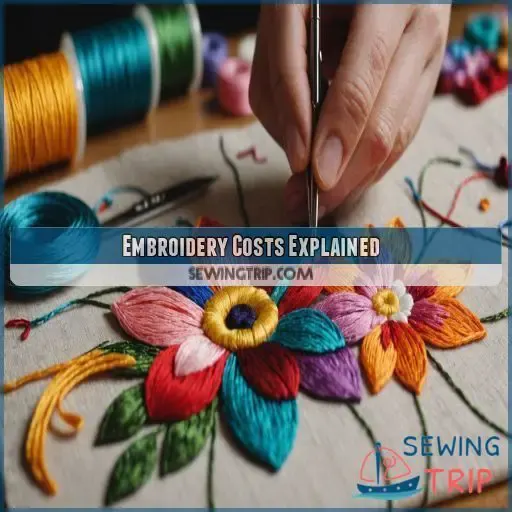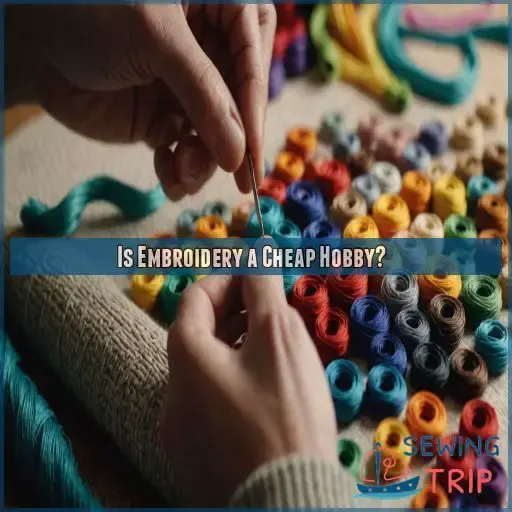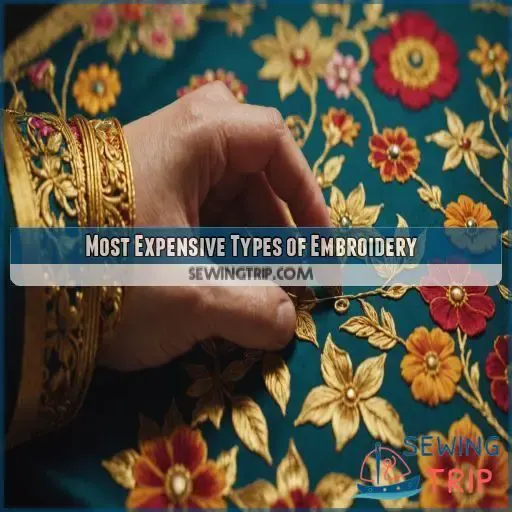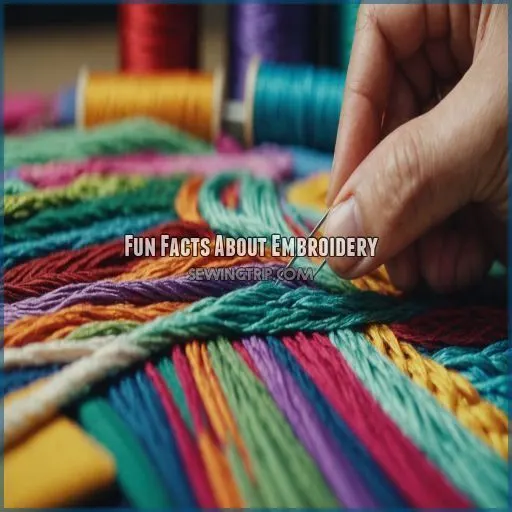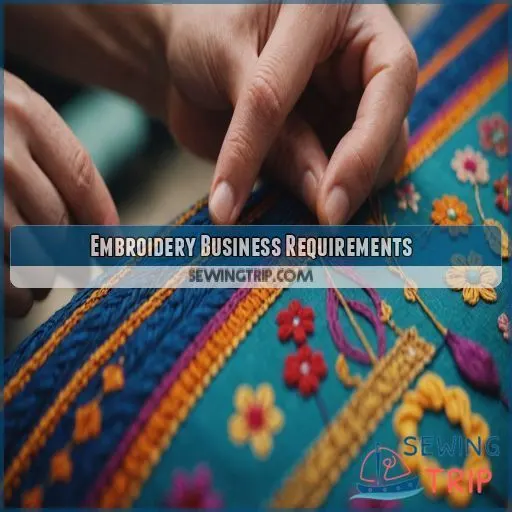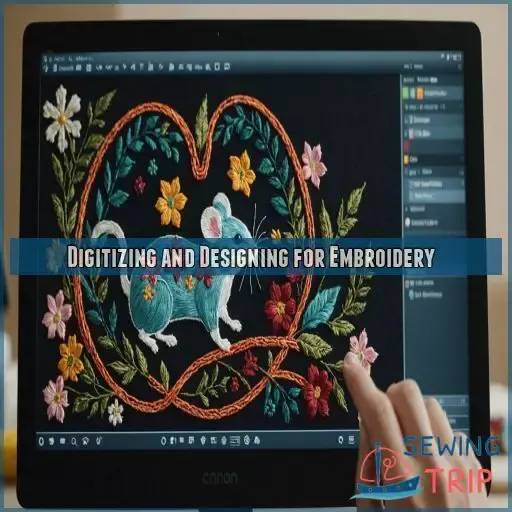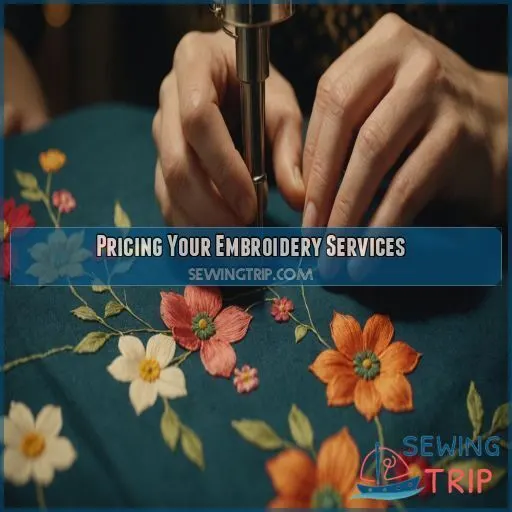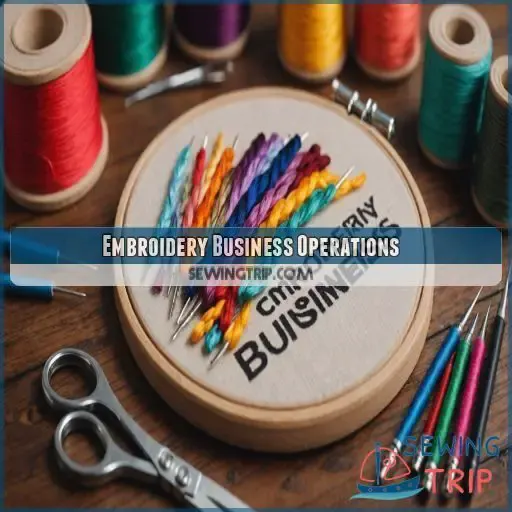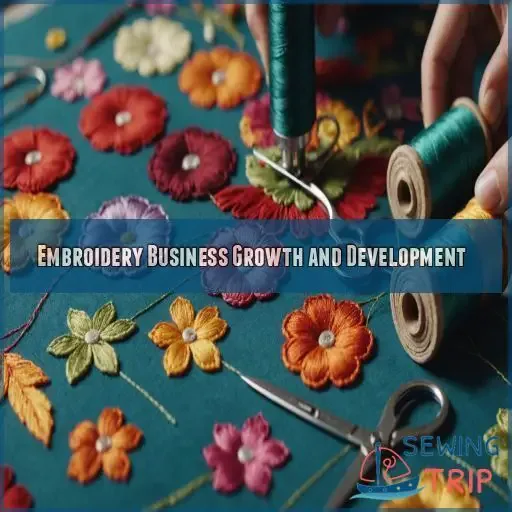This site is supported by our readers. We may earn a commission, at no cost to you, if you purchase through links.
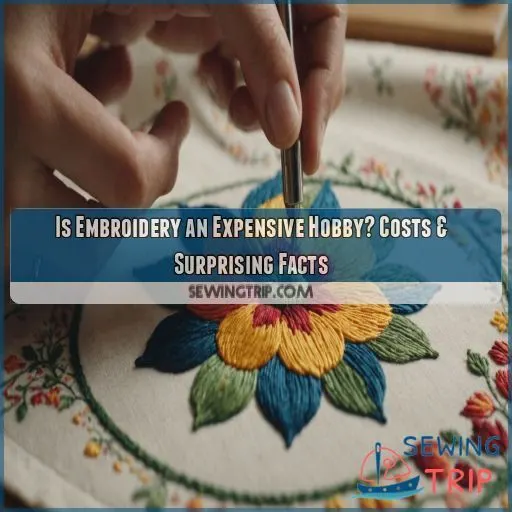
Imagine holding a magical needle, crafting vibrant images on fabric, without making your wallet weep.
Sure, luxurious threads like gold and silver turn heads, but starting simple with budget-friendly threads and basic kits lets you master the craft without a royal budget.
It’s like baking – you don’t need a gourmet kitchen to whip up something tasty.
As you progress, you’ll explore fancy tools or an embroidery machine, feeling like a wizard at work.
Embroidery whispers freedom and creativity, a much more affordable escape than you’d expect.
Ready to stitch your story?
Table Of Contents
- Key Takeaways
- Embroidery Costs Explained
- Is Embroidery a Cheap Hobby?
- Most Expensive Types of Embroidery
- Fun Facts About Embroidery
- Starting an Embroidery Business
- Embroidery Business Requirements
- Digitizing and Designing for Embroidery
- Pricing Your Embroidery Services
- Embroidery Business Operations
- Embroidery Business Growth and Development
- Frequently Asked Questions (FAQs)
- Conclusion
Key Takeaways
- You don’t need a king’s ransom to start embroidery. Think of it like hunting for buried treasure; begin with budget-friendly threads and basic kits. As you refine your skills, you might indulge in some glittering gold threads, but it won’t leave your wallet gasping for air.
- Balancing quality and cost is like walking a tightrope. Dive into the embroidery world where high-quality supplies can elevate your craft, yet savvy spending on essentials can still create magic. Imagine conducting a symphony with thrift-store finds and a sprinkle of creativity.
- Embroidery’s learning curve demands time and patience, like baking cookies from scratch. Start with beginner-friendly projects and short bursts of practice. Track your progress and soon you’ll be stitching tales worthy of bedtime stories.
- Compared to hobbies that gobble up cash faster than a cookie monster at a bake sale, embroidery stands as a gentle giant. It offers a creative escape without emptying your piggy bank, making it a wallet-friendly craft perfect for both novices and seasoned stitchers.
Embroidery Costs Explained
Understanding embroidery costs can be like balancing a tightrope, immersing you in a world where thread prices and intricate designs tangle in an intricate dance. Don’t let the numbers scare you; embroidery is a delightful craft that balances material quality, your skill level, and the right tools for success!
Factors Affecting Embroidery Costs
When it comes to embroidery costs, you’re balancing quite a few threads:
- Thread quality: Fancier threads can make your wallet weep.
- Skill level: Learning curves might need extra supplies or embroidery kits.
- Project complexity: Dreaming big? Complex designs demand more embroidery supplies, perhaps even an embroidery machine!
Keep these in mind as you thread the needle on your budget.
Quality Vs. Cost of Embroidery Supplies
Balancing cost with quality is a tightrope in embroidery. When you budget for supplies, consider that high-quality threads, needles, and hoops elevate your craft, much like a maestro’s baton. Yet, don’t break the bankresearch fabric choices and embroidery tools. Remember, you don’t need to go all out; even budget-friendly options like embroidery floss or yarn can stitch magic efficiently.
Time and Skill Level Required for Embroidery
You’ve weighed the costs—now let’s tackle the embroidery learning curve with style! Embroidery for beginners isn’t just about materials; it’s about understanding time commitment, skill progression, and project complexity. Here’s a stitch in time:
- Start simple: use beginner-friendly stitches.
- Prioritize short, manageable embroidery projects.
- Turn practice into progress—track your skill growth!
Equipment and Tools Needed for Embroidery
Aside from the basics like embroidery hoops and needles, the right equipment can truly elevate your stitching game. Think fabric choices, thread varieties, and even an embroidery stand – these tools open up new techniques and patterns. But don’t worry, you can start small and build up your collection over time.
| Embroidery Essentials | Helpful Extras |
|---|---|
| Embroidery Hoops | Embroidery Stand |
| Needles | Embroidery Scissors |
| Fabric | Embroidery Floss Organizer |
| Thread | Pattern Transfer Tools |
Is Embroidery a Cheap Hobby?
Embroidery can seem like a pricey pursuit with its glittering threads and shiny needles, but don’t let that sew a hole in your wallet just yet! With a smidge of planning and a sprinkle of creativity, this charming craft can be more budget-friendly than diving into a yarn-packed abyss or building a model train empire.
Initial Investment in Embroidery Supplies
Getting started with embroidery doesn’t have to break the bank. Invest in essential tools, such as starter kits and quality threads, for a low-cost entry. Imagine wielding your own magic wand—an embroidery machine—as you master the craft. With a bit of budgeting and creativity, embroidery is an easy-to-start hobby that’s also delightfully easy to learn.
Ongoing Costs of Embroidery Materials
Crafting with embroidery materials can be like a jungle expedition—exciting yet demanding. Thread quality, needle types, hoop sizes, and fabric costs add up over time. Investing in dye variations for colorful embroidery designs can be tempting. Check out embroidery books and classes for budgeting tips. Remember, your wallet’s a tool, not a wishing well! Balance passion with practicality.
Comparison to Other Hobbies and Crafts
For hobbies, embroidery stands out as a surprisingly cost-effective option. Unlike pricey pursuits like golfing or skiing, the upfront investment for embroidery supplies is modest, and the ongoing costs are manageable. Plus, the learning curve is gentler compared to more complex crafts, making it an accessible hobby for beginners.
Benefits of Embroidery as a Cost-Effective Hobby
- Enjoy a creative outlet that sparks joy.
- Embrace reuse materials from past projects.
- Savor the slow craft nature akin to a peaceful stroll.
- Relish embroidery art’s rich history.
- Easily pick up lively embroidery design and gently put them down with the right embroidery machine.
Most Expensive Types of Embroidery
You might think embroidery is just a quiet pastime.
But wait till you see the price tag on gold and silver threads that’ll make you gasp more than running a marathon!
Whether you’re stitching intricate designs or starting on large-scale projects, some embroidery can be as costly as a designer handbag.
This makes even the fanciest custom services feel like a splurge.
Gold and Silver Thread Embroidery
Exploring embroidery, gold and silver thread embroidery stands out like a peacock in a flock of pigeons!
Historically, gold threads dazzled in royal garments.
Today, embroidery enthusiasts cherish these metallic threads for their luxurious appeal.
Silver thread projects require care, but don’t sweat it! Remember, they’re silver.
Gold thread suppliers might lighten your wallet, but their sparkle adds charm like nothing else in embroidery traditions and cultures.
Intricate and Complex Designs
Intricate and complex embroidery designs can be a true test of your skills. The level of detail and precision required can be overwhelming, but the sense of accomplishment when you pull it off is unparalleled. Embrace the challenge, experiment with new techniques, and let your creativity shine through. The journey is half the fun!
Large-Scale Embroidery Projects
Tackling large-scale embroidery projects feels like orchestrating a masterpiece. It’s a wild ride of planning brilliance, often showcased in embroidery galleries or museums. Sure, it demands time, a cool budget, and a solid framework of techniques. Yet, oh, the satisfaction! When entering embroidery contests, these projects weave stories you control, transforming threads into breathtaking tapestries adored by all.
Custom and Bespoke Embroidery Services
Custom and tailored embroidery services are like fine dining for fabric—a luxurious treat.
Personalized designs require client consultations, clever pricing strategies, and careful consideration of project timelines.
Sure, you’ll shell out more, but it’s a canvas masterpiece!
Ethical sourcing is key.
Is embroidery an expensive hobby?
Here are the facts: join embroidery communities or follow embroidery blogs to dive deeper.
Fun Facts About Embroidery
Embroidery isn’t just about pretty patterns; it’s a colorful tapestry woven throughout history, inspiring artists and crafters alike. From Renaissance masterpieces to quirky socks, this age-old craft brings a creative flair to your wardrobe and maybe even makes you an accidental fashion trendsetter.
History of Embroidery and Its Cultural Significance
The history of embroidery is a rich tapestry woven through the ages. From ancient civilizations to modern times, this versatile craft has held cultural significance, serving as a means of storytelling, status symbol, and expression of identity. Techniques like the satin stitch have evolved, making embroidery an accessible, portable hobby that can be enjoyed anywhere.
Famous Embroidery Artists and Their Work
Talking about embroidery artists is like diving into a vibrant tapestry!
Ever heard of Sarah K. Benning?
Her work redefines modern embroidery with bold designs and DIY flair.
Tracey Emin, with her raw, emotional pieces, brilliantly interweaves text and fabric.
Unique and Unusual Embroidery Techniques
While famous artists stitch stories, you might explore quirky embroidery techniques like free-motion embroidery, where your needle dances as freely as a bird! Try shadow work for a whisper of fabric magic or goldwork for a touch of royalty. Surface stitching and bead embroidery add texture and shine. These open doors to creativity, empowering your artistic journey.
Embroidery in Modern Fashion and Design
In today’s fashion scene, embroidered clothing is a dazzling trend that’s stitched into the heart of sustainable fashion. Imagine jackets blooming with intricate designs or jeans adorned with modern embroidery art. Brands are sewing stories into fabrics, transforming clothes into canvases. Explore these embroidery techniques, and who knows, you’ll might find yourself bedecked in uniquely embroidered masterpieces!
Starting an Embroidery Business
Starting an embroidery business can be an exciting and rewarding venture, but it requires careful planning and consideration. From essential equipment and software to pricing and marketing strategies, there’s a lot to navigate – but with the right approach, you can turn your passion for embroidery into a thriving enterprise.
Essential Equipment and Software Needed
Embroidery isn’t just about threading a needle; it’s an exploration! To start, you’ll need an embroidery machine, various hoop sizes, digitizing software, diverse thread types, and needle sizes that match your flair. Think of these as your trusty crew on this creative adventure. With the right gear, you’re not just stitching—you’re crafting masterpieces!
Pricing and Quoting for Embroidery Services
When pricing your embroidery, think of it like crafting a perfect recipe: blend project complexity, materials cost, and client expectations.
Start with a fair pricing model, accounting for time and skill.
Then, add service packages to sweeten the deal.
After all, a happy client is the frosting on the cake!
Marketing and Promoting Your Embroidery Business
Creating a buzz about your embroidery business? Get into social media strategy and charm audiences with your unique creations! Share stories, utilize client testimonials, and explore online marketplaces. Don’t forget, networking events are goldmines for connections. Want a sprinkle of magic? Email marketing casts a wider net, letting your creativity shine while attracting future embroidery enthusiasts with ease. Happy stitching!
Managing Finances and Taxes for Your Business
Managing your embroidery business’s finances and taxes can feel like working through a maze.
With the right strategies, you can turn it into a well-oiled machine.
From securing the proper business licenses to maximizing tax deductions, smart record-keeping, and budgeting, these financial fundamentals will set your embroidery venture up for long-term success.
Don’t let the paperwork scare you – embrace it as part of your entrepreneurial journey!
Embroidery Business Requirements
Starting an embroidery business is like sewing your ambitions into reality, but you’ll need more than just thread and needles; you’ll need to tackle business registration, licensing, and insurance to weave a strong foundation. Don’t worry, sorting out the necessary qualifications and compliance with industry regulations is stitched with tiny steps, not leaps!
Qualifications and Certifications for Embroidery
You’ve got your embroidery business dream set now, let’s talk embroidery certifications. While not mandatory, they offer you a badge of mastery, showcasing your skills like a peacock flaunting its feathers. Industry standards don’t stand a chance against your creativity when you leverage recognized programs. Through professional development, certification benefits magnify your expertise, opening doors to exciting opportunities.
Business Registration and Licensing
Running an embroidery business starts with threading the needle of business licenses and registration requirements.
It’s your legal safety net, ensuring you’re compliant with industry regulations.
Choose your business structure wisely; it’s like picking the right fabric—it determines flexibility and strength.
Don’t skip these steps, or you might unravel all that hard work before you’ve even begun!
Insurance and Liability for Embroidery Businesses
As an embroidery business owner, protecting yourself with the right insurance is really important.
Business liability coverage shields you from costly lawsuits if a customer gets injured using your products.
Plus, product liability insurance safeguards your creations.
Consult a local agent to find the perfect policy – it’s an investment in your peace of mind and the longevity of your thriving embroidery venture.
Compliance With Industry Regulations
Stepping from insurance to industry compliance might feel like crossing a bustling highway, but it’s a smooth ride with the right map.
Embrace the journey by understanding safety standards, labor laws, and licensing requirements.
Ethical sourcing matters too!
Keep your embroidery business on the right side of the tracks and you’ll create not just beauty, but a legacy that threads joyfully through generations.
Digitizing and Designing for Embroidery
Embrace the art of embroidery by mastering the magic of digitizing and designing, where your creativity meets technology in delightful harmony. You’ll find that crafting custom designs for your projects or clients adds a vibrant touch to your hobby, offering unexpected joys and occasional ‘oops’ moments with your trusty software.
Software and Tools for Embroidery Design
After mastering the basics of embroidery business logistics, it’s time to explore embroidery design wonders! Ready to bring your designs to life? Embroidery software is your magic wand, offering design tools and digitizing techniques. Whether you’re crafting with embroidery fonts or scouring design resources, these tools turn dreams into stitches. Embrace technology’s embrace and watch your creativity soar!
Creating Custom Designs for Clients
Designing custom embroidery for clients is an exciting opportunity to showcase your creativity. Start by understanding their vision – what colors, motifs, or styles do they prefer? Then, use your design software skills to bring their ideas to life. Charge appropriately for your expertise, and build a portfolio to attract more custom work.
- Discuss client preferences
- Utilize design software effectively
- Price custom designs strategically
- Develop a strong design portfolio
Outsourcing Design Services for Embroidery
Starting out with embroidery? Consider outsourcing design services to freelancers or design platforms. This clever move lets you tap into fresh creativity without breaking the bank. Focus on design quality by choosing skilled freelancers. It’s like having an art gallery at your fingertips! Who knows? This might just spark your inner Picasso while you maintain control over your creative masterpiece.
Pricing and Charging for Design Services
Outsourcing design services mightn’t fit every budget, so let’s talk about pricing your own design services. Balance client budgets with hourly rates—consider project scope and offer a compelling value proposition. Remember, you’re not just selling designs; you’re providing creativity wrapped in thread. Like a master chef with spices, mix your skills to match every client’s taste perfectly!
Pricing Your Embroidery Services
Setting the right price for your embroidery services can feel like threading a needle on a roller coaster, but it’s essential for success! You’ll need to factor in costs, time, and market rates, and soon enough, your pricing structure will be as neat as your best stitches.
Calculating Costs and Time Required for Projects
Calculating the costs and time needed for your embroidery projects is really important for pricing your services accurately. Break down each step, from material expenses to labor hours, to make sure you’re covering your costs and earning a fair profit. Tracking your budget will help you stay on top of your finances and make smart purchasing decisions.
Researching Competitors and Market Rates
Venturing into embroidery business requires some detective work. Pricing strategies can feel like a maze, but you’ve got this! Explore these steps:
- Compare competitor pricing like you’re Sherlock Holmes on a mission.
- Dive deep into market trends—swim with the tides, not against them.
- Benchmark against industry standards, because everyone loves a savvy operator!
Creating a Pricing Structure for Your Business
You’ve checked out your competitors, now it’s time to build your pricing strategy.
Think of it like a recipe: mix cost analysis, labor rates, and profit margins with a pinch of creativity.
Don’t just pick random numbers; make sure your prices reflect your effort and market research.
Embroidery Business Operations
Running an embroidery business is like organizing a stitch-by-stitch parade—exciting but needing precise coordination! You’ll be juggling orders, deadlines, and customer expectations while dreaming up new ways to keep those needles dancing and clients smiling.
Managing Orders and Client Communication
Staying on top of orders and keeping clients in the loop is key to running a successful embroidery business, and managing finances effectively is a crucial part of that. Use order tracking software to monitor progress, and send regular project updates to clients. Respond promptly to inquiries and feedback – great communication builds trust and loyalty. With the right tools, you can streamline the process and delight your customers.
Scheduling and Meeting Deadlines
Mastering deadlines in embroidery is about juggling creativity and time. To keep the threads from tangling:
- Prioritization: Focus on projects by importance.
- Realistic Goals: Set achievable timelines—Rome wasn’t embroidered in a day!
- Time Management: Allocate specific hours for stitching magic, like stitching between episodes of your favorite show.
Balance the art, and deadlines become a tapestry of success.
Quality Control and Ensuring Customer Satisfaction
Keeping a sharp eye on quality control can make or break your embroidery business. Accurate orders and great client communication are key. So, always check twice and humorously invite feedback because who doesn’t love a good stitch pun? Crafting a solid return policy also helps weave trust with your clients. Here’s a quick reference:
| Step | Description | Benefit |
|---|---|---|
| Quality Checks | Double-check your work | Guarantee order accuracy |
| Feedback | Ask for customer input | Improve satisfaction |
| Client Comms | Keep communication open | Build strong relations |
| Return Policy | Clear guidelines | Boost customer trust |
Continuously Improving and Expanding Services
You’ve got your hands full ensuring quality, so why not level up by embracing client feedback? Here are some tips to keep your embroidery business flying high:
- Explore New Skills: Pursue workshops to stay ahead.
- Invest in Upgraded Tools: They make life’s easier.
- Launch New Products: Think outside the hoop.
- Follow Market Trends: Adapt or get left behind!
Embroidery Business Growth and Development
If you’re ready to grow your embroidery business, focus on expanding your client base and marketing your unique style. It might be time to upgrade your skills and technology too, so you’re not stitching with ancient tools like you’re straight out of a medieval tapestry!
Expanding Your Client Base and Marketing
Expand your client base by leveraging social media and networking. Reach out to potential customers through platforms like Instagram and LinkedIn. Offer referral incentives to existing clients – they’ll be happy to spread the word about your excellent embroidery services. Collaborate with local businesses for cross-promotion opportunities. An active online presence is key to growing your embroidery empire.
Developing New Skills and Services
Ever thought of dabbling in embroidery workshops or online courses? It’s like expanding your artistic palette! You’ll craft custom designs and explore upcycling projects with sustainable materials—no need to reinvent the wheel. Who knew thread could lead to mastery? It’s not rocket science, just a stitch in time saving nine! You’re the Picasso of needlework, after all.
Investing in New Equipment and Technology
Investing in new embroidery machines and software upgrades can transform your crafting experience, but finding a good deal is key to making it a more affordable hobby.
Think of digitizing tools as your personal magic wands; they turn wild ideas into stitched reality!
Upgrading your sewing machine is like giving it turbo boots, ensuring efficiency and precision.
Embrace these embroidery software enhancements not just for convenience, but for the pure joy of creating with ease and mastery.
Building a Strong Online Presence and Community
You’ve upgraded your gear, now it’s time to shine online!
Craft a social media strategy as colorful as your embroidery threads.
Host online workshops that stitch folks together.
Keep a content calendar so your posts look as polished as your projects.
Engage with your community like chatting at a cozy craft fair.
Who knows? Collaborative projects might just weave unexpected magic!
Frequently Asked Questions (FAQs)
Why is embroidery so expensive?
Embroidery can make your wallet groan because quality materials, like silky threads and sturdy hoops, often come with hefty price tags. Saving smarter by setting budgets or hunting for sales can keep your creative juices flowing without breaking the bank!
Is embroidery a cheap hobby?
Embroidery’s cost, like a curious journey, varies. You can start with thrifted hoops and thread for pennies or splurge on luxury materials. It’s what you stitch that counts, not the wallet size.
What is the most expensive type of embroidery?
You’re on a quest for opulence! goldwork embroidery is the answer. It uses real gold threads and metallic materials. It’s intricate, regal, costly, and a tad extravagant—perfect for feeling like royalty while stitching!
What is a fun fact about embroidery?
Did you know embroidery can be a meditative practice that connects you to centuries of textile artistry? Get lost in the rhythmic stitches and express your creative flair – the possibilities are endless!
What are the ongoing costs of embroidery?
Did you know 59% of embroiderers spend under $500 annually? You’ll want to budget for thread, fabric, needles, and the occasional splurge on a fancy hoop. But don’t worry, even the best artists started with scraps!
How can I find affordable embroidery supplies?
To find affordable embroidery supplies, channel your inner detective: scour thrift shops, hunt for sales, and check out online forums for shared deals. Remember, patience and persistence are your trusty sidekicks in this creative treasure hunt.
What are the health benefits of embroidery?
Embroidery‘s a great hobby for your health! It calms your mind like yoga, boosts creativity, and offers a break from daily stress. Stitch by stitch, you’ll find relaxation and a sense of mastery over your craft.
How do I care for embroidered items?
Caring for your embroidered treasures is a labor of love! Gently hand-wash in cool water, lay flat to dry, and store in a cool, dry place. With a little TLC, your stitches will shine for years to come. Embrace the journey, my friend!
Can children learn embroidery as a hobby?
Kids can jump into embroidery and stitch their own little masterpieces. It’s like painting with threadfun, imaginative, and skill-building. Start with simple patterns and watch their creativity bloom stitch by colorful stitch!
Conclusion
They say, "beauty is in the eye of the beholder," and embroidery proves that beauty doesn’t have to be expensive.
So, is embroidery an expensive hobby?
You can kick off without breaking the bank by selecting budget-friendly threads and basic kits.
As you hone your skills, you’ll navigate costs smartly while perhaps splurging on occasional luxe elements.
Embrace this creative escape, where every stitch tells your unique story, and costs remain flexible.

